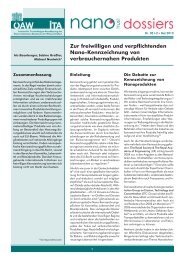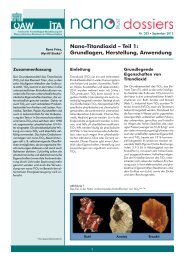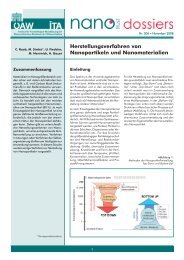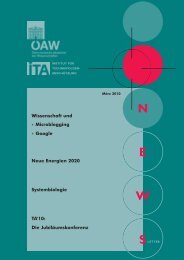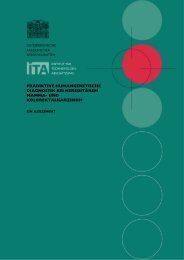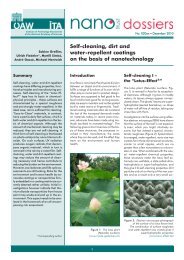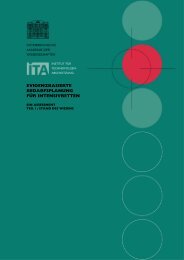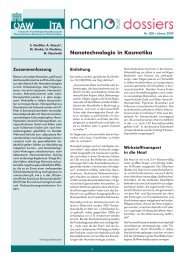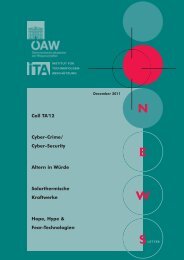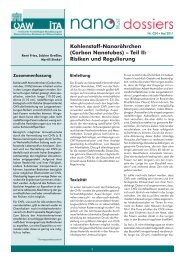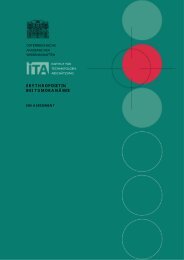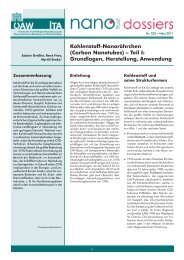- Seite 1 und 2: Bibliographie zum Nachleben des ant
- Seite 3 und 4: I. ALLGEMEINE HILFSMITTEL I.1. Hilf
- Seite 5 und 6: I.2.2. Lexika zur antiken Mythologi
- Seite 7 und 8: II. FORSCHUNGSPROJEKTE ZUM NACHLEBE
- Seite 9 und 10: III. PUBLIKATIONEN ZUM NACHLEBEN DE
- Seite 11 und 12: J.-P. Vernant, Mythos ohne Illusion
- Seite 13 und 14: F. Cappelletti, Festina lente: Fort
- Seite 15 und 16: W. Killy, Mythographie der frühen
- Seite 17 und 18: R. Benz, Wandel des Bildes der Anti
- Seite 19 und 20: D. Bush, Mythology and the Renaissa
- Seite 21 und 22: J.-P. Néraudau, L´Olympe du Roi-S
- Seite 23 und 24: B. Lenotti, Le leggende del Garda,
- Seite 25 und 26: Ungarn T. Klaniczog (Hrsg.), Antike
- Seite 27 und 28: W. Gundel, Dekane und Dekansternbil
- Seite 29 und 30: Latin Writings of the Italian Human
- Seite 31: Petrarch’s Africa, transl. and an
- Seite 35 und 36: Leon Battista Alberti. Momus o del
- Seite 37 und 38: L. Bertalot, Lauri Quirini ‚Dialo
- Seite 39 und 40: • Ausgabe: Elisii Calentii Poemat
- Seite 41 und 42: Ioannis Aurelii Augurelli Poetae Ar
- Seite 43 und 44: Sebastian Brant (1458-1521) Das Nar
- Seite 45 und 46: G. Gardenal, Il Poliziano e Suetoni
- Seite 47 und 48: Celio Calcagnini (1470-1541), Descr
- Seite 49 und 50: St. Füssel, Dichtung und Politik u
- Seite 51 und 52: Robert Estienne, Dictionarium nomin
- Seite 53 und 54: J. Köhler, Der ‚Emblematum liber
- Seite 55 und 56: Pietro Bembo, Gorgiae Leontini in H
- Seite 57 und 58: W.D. Müller-Jahncke, Die Krankheit
- Seite 59 und 60: B.Tiemann, Fabel und Emblem. Gilles
- Seite 61 und 62: K. Stackmann, Die Auslegungen des G
- Seite 63 und 64: H. Marek, Narziß und Pygmalion. Po
- Seite 65 und 66: P.-R. Robiquet, De Ioannis Aurati p
- Seite 67 und 68: Edipo, Padova 1556. (Sophokles-Bear
- Seite 69 und 70: Etienne Jodelle (1532-1573) Orphée
- Seite 71 und 72: John Dee (1527-1608), Monas Hierogl
- Seite 73 und 74: Jacopo Zucchi (1541-1589/90), Zeita
- Seite 75 und 76: Bernardino Baldi, L’ invenzione d
- Seite 77 und 78: Luis de Góngora y Argote (1561-162
- Seite 79 und 80: Luigi Groto (1541-1585), La Calisto
- Seite 81 und 82: Sebastián de (H)orozco y Covarrubi
- Seite 83 und 84:
Giovanni Villefranchi ( ?- ?), Astr
- Seite 85 und 86:
B. Thaon, Spenser’s Neptune, Nere
- Seite 87 und 88:
La Dafne (Musik: M. Gagliano), Fire
- Seite 89 und 90:
L’harmonie étymologique des lang
- Seite 91 und 92:
Ch.W. Lemmi, The Classical Deities
- Seite 93 und 94:
Schäfferey von de Nimfen Hercinie,
- Seite 95 und 96:
Gigantomachia; Oratio in qua probat
- Seite 97 und 98:
L´Endimion (Roman), Paris 1624. Le
- Seite 99 und 100:
Juan Tassis de Peralta (1582-1622),
- Seite 101 und 102:
R. Falconer, Orpheus dis(re)membere
- Seite 103 und 104:
• Ausgabe: La lira de las musas,
- Seite 105 und 106:
Ascanio Pio di Savoia (?-1649), L
- Seite 107 und 108:
Arnaud (?-?), Agamemnon (Tragödie
- Seite 109 und 110:
Carlo Bentivoglio (1615-1661), Il M
- Seite 111 und 112:
J.P. Pomareda, Consideraciones sobr
- Seite 113 und 114:
projects, Princeton 1977 (= Princet
- Seite 115 und 116:
Huginus á Barma (?-?), Saturnia re
- Seite 117 und 118:
Georgius-Caspar Kirchmayer (Kirchma
- Seite 119 und 120:
Caspar Christophorus Dauderstadius
- Seite 121 und 122:
Il silenzio di Harpocrate, Dramma p
- Seite 123 und 124:
P. Gaultruche (1602-1681), L’Hist
- Seite 125 und 126:
Camillo Badovero (?-?) Il Leandro.
- Seite 127 und 128:
Thétis et Pelée, Oper, Paris 1689
- Seite 129 und 130:
Circe, Leipzig 1697. Der geliebte A
- Seite 131 und 132:
• Literatur: H. Laufhütte, Progr
- Seite 133 und 134:
Georg Browallius (?-1705), Disserta
- Seite 135 und 136:
Anon. (L.A.D.S.M.), Ulysse et Circ
- Seite 137 und 138:
August Bohse (1661-1730), Amor am H
- Seite 139 und 140:
Camilla, regina dei Volschi. Dramma
- Seite 141 und 142:
adventus Monachium in Bavariam, fil
- Seite 143 und 144:
Electre, tragédie, Paris 1708. Lou
- Seite 145 und 146:
La corona d’Arianna, Festa teatra
- Seite 147 und 148:
• Ausgabe: H. Federhofer (Hrsg),
- Seite 149 und 150:
Stefano Serangeli (?-?), Il Creso r
- Seite 151 und 152:
Partenope. (Musik: J.A. Hasse), Wie
- Seite 153 und 154:
Poetische Unterredung zwischen dem
- Seite 155 und 156:
S.M. Schreiner, Die Metamorphose de
- Seite 157 und 158:
Joseph de Solís y Gante (?-1770),
- Seite 159 und 160:
Elie Blanchard (1672-1755), Mémoir
- Seite 161 und 162:
Niccola Marini (1704-1790) Il natal
- Seite 163 und 164:
Polymetis or an enquiry concerning
- Seite 165 und 166:
Johann Georgius Albertinus (1716-17
- Seite 167 und 168:
Jean Joseph Vade (1719-1757) La fil
- Seite 169 und 170:
Guillaume-Alexandre de Mélégan (1
- Seite 171 und 172:
Antoine-Yves Goguet (1716-1758), De
- Seite 173 und 174:
Pijon (“M. de la Volierre”) (17
- Seite 175 und 176:
Sammlung antiquarischer Aufsätze,
- Seite 177 und 178:
Electre, tragédie, Paris 1782. Joh
- Seite 179 und 180:
O. Brendel, Iphigenie auf Tauris -
- Seite 181 und 182:
Pierre Nicolas Brunet (1733-1771),
- Seite 183 und 184:
Deukalion und Pyrrha - Ein musikali
- Seite 185 und 186:
Friedrich Wilhelm Gotter (1746-1797
- Seite 187 und 188:
Histoire de l´astronomie ancienne,
- Seite 189 und 190:
Francesco Clerico (1755-1838) Diana
- Seite 191 und 192:
Palämon. Ein Gedicht, Halle 1778.
- Seite 193 und 194:
Alessandro Verri (1741-1816) Le avv
- Seite 195 und 196:
Die Künstler. In: Ttsch. Merkur 17
- Seite 197 und 198:
• Ausgaben: Numa Pompilius übrse
- Seite 199 und 200:
Mythologische Briefe, Königsberg 1
- Seite 201 und 202:
Versuche über einige Gegenstände
- Seite 203 und 204:
Mythologisches Wörterbuch, Berlin
- Seite 205 und 206:
Stefano Giuseppe Antonio Gavuzzi (1
- Seite 207 und 208:
Der Gott der Jugend. In: Musen-Alma
- Seite 209 und 210:
José Iglesias de la Casa (1748-179
- Seite 211 und 212:
Bildung; Bd.II: Weitere Ausführung
- Seite 213 und 214:
Charles-Etienne Gaucher (1741-1804)
- Seite 215 und 216:
von Günderode. Briefe und Dichtung
- Seite 217 und 218:
19. Jahrhundert Johann Joseph Bürk
- Seite 219 und 220:
José Mariano Beristáin (y Martín
- Seite 221 und 222:
August Friedrich Ferdinand von Kotz
- Seite 223 und 224:
(...) des königlichen Schlosses (.
- Seite 225 und 226:
H. Gallas, Antikenrezeption bei Goe
- Seite 227 und 228:
Arkadien, Roman, 1811. (verschollen
- Seite 229 und 230:
Distichen (Achill; Helena; Narziß)
- Seite 231 und 232:
Erzählende Schriften, dramatische
- Seite 233 und 234:
Neue Lieder der Griechen, Leipzig 1
- Seite 235 und 236:
André Chénier (1762-1794) Œvres
- Seite 237 und 238:
Pietro Bagnoli (1767-1847), Il Cadm
- Seite 239 und 240:
Erstdrucke: Ferdinand Raimunds säm
- Seite 241 und 242:
Über homerische Geographie und Wel
- Seite 243 und 244:
R. Martin, Die Wiederkehr der Gött
- Seite 245 und 246:
Jacopo Mantoani (?-?), Ecuba. Trage
- Seite 247 und 248:
Otto I. Jahn (1813-1869) Palamedes.
- Seite 249 und 250:
musikalisches Intermezzo in 2 Abthe
- Seite 251 und 252:
Frederic Duhomme (?-?), Elie Sauvag
- Seite 253 und 254:
Johann Joseph Polt (1775-1861), Num
- Seite 255 und 256:
Aeneas H. Bardon, L´Enéide et l´
- Seite 257 und 258:
C. Settis Frugoni, An Ascent of Ale
- Seite 259 und 260:
E. Beyfuß, Die Antigone-Sage in de
- Seite 261 und 262:
Literatur des 17. und 18. Jahrhunde
- Seite 263 und 264:
R. Chevallier (Hrsg.), Présence de
- Seite 265 und 266:
Cupido s. Amor Marcus Curtius s. Sa
- Seite 267 und 268:
W. Weisbach, Der sogenannte Geograp
- Seite 269 und 270:
B. Guthmüller, Europa und der Stie
- Seite 271 und 272:
B. Gatz, Weltalter, goldene Zeit un
- Seite 273 und 274:
B. Heitmann, Gut und Böse im Wider
- Seite 275 und 276:
Hero und Leander M. H. Jellinek, Di
- Seite 277 und 278:
F.M. Godfrey, Paintings of the Lege
- Seite 279 und 280:
D. Schubert, Halbfigurige Lucretia-
- Seite 281 und 282:
Mercurius W.A. van Es, Mercurius at
- Seite 283 und 284:
s. auch Poussin, Pontus de Tyard Na
- Seite 285 und 286:
Ulisse: Il mito e la memoria. Catal
- Seite 287 und 288:
G. Freyburger - J.-Ch. Tautil, Un t
- Seite 289 und 290:
H. Flasche, Antiker Mythos in chris
- Seite 291 und 292:
H. Meller, Prometheus im romantisch
- Seite 293 und 294:
Marcus Atilius Regulus: E.R. Mix, M
- Seite 295 und 296:
Spartacus A.J.I. van Hooff, De vonk
- Seite 297 und 298:
P. Fehl, The Worship of Bacchus and
- Seite 299 und 300:
Boethius • Literatur: H. R. Patch
- Seite 301 und 302:
Georg Pasor, Hesiodi quae extant cu
- Seite 303 und 304:
E. Spanheim, Observationes in Calli
- Seite 305 und 306:
Ovid • Ausgaben: Pierre Bersuire
- Seite 307 und 308:
A. Martindale (Hrsg.), Ovid Renewed
- Seite 309 und 310:
• Literatur: R. Guerrini, Plutarc
- Seite 311 und 312:
Vindelinus de Spira, Venetiis 1470.



